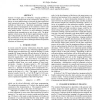Free Online Productivity Tools
i2Speak
i2Symbol
i2OCR
iTex2Img
iWeb2Print
iWeb2Shot
i2Type
iPdf2Split
iPdf2Merge
i2Bopomofo
i2Arabic
i2Style
i2Image
i2PDF
iLatex2Rtf
Sci2ools
ICASSP
2011
IEEE
2011
IEEE
Analysis of unknown velocity and target off the grid problems in compressive sensing based subsurface imaging
Sparsity of target space in subsurface imaging problem is used within the framework of the compressive sensing (CS) theory in recent publications to decrease the data acquisition load in practical systems. The developed CS based imaging methods are based on two important assumptions; namely, that the speed of propagation in the medium is known and that potential targets are point like targets positioned at discrete spatial points. However, in most subsurface imaging problems these assumptions are not always valid. The propagation velocity may only be known approximately, and targets will generally not fall on the grid exactly. In this work, the performance of the CS based subsurface imaging methods are analyzed for the above defined problems and possible solutions are discussed.
ICASSP 2011 | Signal Processing | Subsurface Imaging | Subsurface Imaging Methods | Subsurface Imaging Problem |
| Added | 21 Aug 2011 |
| Updated | 21 Aug 2011 |
| Type | Journal |
| Year | 2011 |
| Where | ICASSP |
| Authors | Mehmet Ali Çagri Tuncer, Ali Cafer Gurbuz |
Comments (0)

